 |
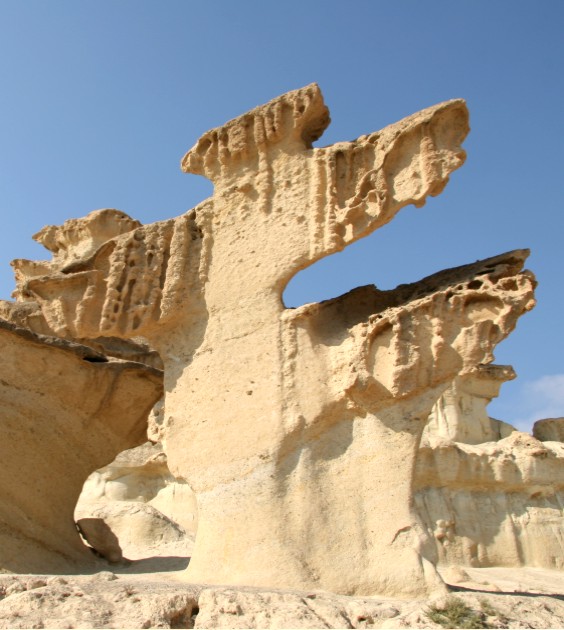 |
 | |
 | |
 | |
 | |
 | |
 | |
 | |
 | |
 | |
 | |
 | |
 | |
 | |
 |
Comunidad Autónoma de Murcia - Costa Calida |
Mazarron - Costa Calida : welcome to paradise. |
The bay of Mazarrón is a gulf (from Cabo Tiñoso to Cabo Cope). A coastline that is rich in diversity, where you can find abounding breathtaking forms of excavations or erosions (Bolnuevo), but also deposits, hence carving out almost 40 beaches. If to this we add the annual average temperature of 18°C and annual average of more than 300 sunny days a year, we can appreciate that Bay of Mazarrón is a real paradise. 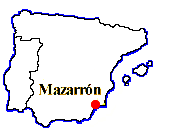 Mazarrón (town and Port) is located in the south-east of Spain, in the Region of Murcia and next to the Mediterranean Sea. Mazarrón covers 318 km² and has 35.000 inhabitants. Mazarrón (town and Port) is located in the south-east of Spain, in the Region of Murcia and next to the Mediterranean Sea. Mazarrón covers 318 km² and has 35.000 inhabitants.Mazarron offers visitors a rich artistic heritage and interesting leisure activities by the seashore. A fishing port, two marinas and more than 35 km of beaches, virgin sandy coves and rocky bottoms, which constitute an ideal place to rest in the sun, practise nautical sports and scuba diving, as well as taste the local gastronomy. The fishing port and the fish market help to better value the local and the traditional kitchen. In Mazarron you can find sea, mountain, countryside, a past of sailors, a present of farmers and a future of tourists. The various villages in Mazarron : Bolnuevo - Camposol - Cañada de Gallego - Cañadas del Romero - El Saladillo El Garrobo - Gañuelas - Ifre-Pastrana - La Atalaya - La Majada - Las Balsicas - Las Moreras - Los Rincones - Leiva |
 Festivals : The Milagro Festivals (celebrated in Bolnuevo and Mazarrón). The sunday preceding the 17th november the Patron, "La Purísima", is carried from Bolnuevo to Mazarrón, and on the sunday following the 17th november, it is taken down, leading a procession, to the "Ermita de Bolnuevo". It is during this week when that many events are celebrated, like the floral offer to the Virgin, processions and religious activities. On the "Romería" Sunday are held Moors and Christians parades, commemorating the Moorish invasion in our coast (which was the reason why the Virgin miraculously interceded, expelling the Argelines from our coast, the night of the 17th november, 1585). The "Fiestas Patronales" are celebrated on the 19th march, the Saint Jose's Day (during the week before, they celebrate open-air dances, sports activities, a "Falla" monumental is set in the Port Beach with figures that criticize all the events which occurred during the year, and a race of torches). On the 16th july, they celebrate the festivity of the "Virgen del Carmen" with a Mass at the Fish Market, a religious procession, carrying the Virgin by sea and land, in which dozens of boats participate, decorated with multicoloured flags. Festivals : The Milagro Festivals (celebrated in Bolnuevo and Mazarrón). The sunday preceding the 17th november the Patron, "La Purísima", is carried from Bolnuevo to Mazarrón, and on the sunday following the 17th november, it is taken down, leading a procession, to the "Ermita de Bolnuevo". It is during this week when that many events are celebrated, like the floral offer to the Virgin, processions and religious activities. On the "Romería" Sunday are held Moors and Christians parades, commemorating the Moorish invasion in our coast (which was the reason why the Virgin miraculously interceded, expelling the Argelines from our coast, the night of the 17th november, 1585). The "Fiestas Patronales" are celebrated on the 19th march, the Saint Jose's Day (during the week before, they celebrate open-air dances, sports activities, a "Falla" monumental is set in the Port Beach with figures that criticize all the events which occurred during the year, and a race of torches). On the 16th july, they celebrate the festivity of the "Virgen del Carmen" with a Mass at the Fish Market, a religious procession, carrying the Virgin by sea and land, in which dozens of boats participate, decorated with multicoloured flags.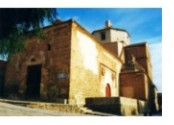 The monuments : The majority of the monuments are found in the town. Among these monuments, we can highlight the Town Hall « Ayuntamiento », dating back to the XIX century and an artistic-historic national monument, as well as the church of "San Andrés" or "la Torre de Santa Elena". There are also other monuments, which have been declared as the Heritage of Cultural Interest : "la Torre de Santa Isabel", "la Torre de los Caballos", "el Castillo de Los Vélez" and "el Molinete". The monuments : The majority of the monuments are found in the town. Among these monuments, we can highlight the Town Hall « Ayuntamiento », dating back to the XIX century and an artistic-historic national monument, as well as the church of "San Andrés" or "la Torre de Santa Elena". There are also other monuments, which have been declared as the Heritage of Cultural Interest : "la Torre de Santa Isabel", "la Torre de los Caballos", "el Castillo de Los Vélez" and "el Molinete".For old castle and/or military forts lovers, taking the old road (carretera) between Mazarron and Cartagena, on the right side (after you go into the mountains) you will find a road to the Mazarron old fort. This military fort was built, improved and used by military forces (artillery) during Franco's leadership. Here you will find very big cannons and you can visit the fort.  Discover the marine treasures : Discover the marine treasures :In its waters, you can find the most important ecosystems of the Mediterranean, the land of Poseidon ( Posidonia oceanica ). It possesses important marine vegetation where you can find sea basses, lobsters, conger eels, dolphins, whales, octopus and morays. The diving center of Mazarron is a sport club for underwater activities. Diving takes place particularly in the Mazarron sea bay, in the area of cape Tiñoso and the Cueva de Lobos (cave of the wolves).  Activities : Activities :The water offers the chance to practise canoeing, sailing, windsurfing, driving and ski-jet riding. Once on land, you can take the routes on bicycles, motorbikes, horse-riding and hiking. In addition, if you would like to keep your feet above ground, you could just do hang-gliding or zip-wiring.  The orchards and the sea : The orchards and the sea :The orchard and sea products are the basis of Mazarrón's gastronomy, in which we can highlight dishes such as rice with lobster or special cooked tomatoes dishes. The sea bass cooked Mazarrón style, "Migas", milt cooked open, salted fish, and noodles with "bonito" are some of local fish used in the Mazarrón's gastronomy. 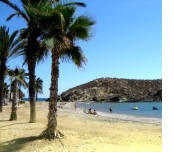 Beaches : Playa del Mojón - Playa de La Raja - Playa Negra - Playa del Alamillo - Playa El Rihuete - Playa del Puerto de Mazarrón - Playa de La Isla - Playa de La Ermita - Playa de Bahía - Playa de La Reya - Playa de La Pava - Playa de Nares - Playa del Castellar - Playa de Bolnuevo - Playa del Rincón - Playa de Piedra Mala - Playa Cueva de Lobos - Playa Amarilla - Playa de La Grúa - Playa Cala de Leño - Cala Desnuda - Playa del Barranco Ancho - Playa Hondón del Fondo - Playa Cabezo de Pelea - Playa Cobaticas - Playa de Las Chapas - Playa del Ballenato - Playa de Percheles - Playa de Las Minas - Playa del Palomarico - Playa Parazuelos, ... Beaches : Playa del Mojón - Playa de La Raja - Playa Negra - Playa del Alamillo - Playa El Rihuete - Playa del Puerto de Mazarrón - Playa de La Isla - Playa de La Ermita - Playa de Bahía - Playa de La Reya - Playa de La Pava - Playa de Nares - Playa del Castellar - Playa de Bolnuevo - Playa del Rincón - Playa de Piedra Mala - Playa Cueva de Lobos - Playa Amarilla - Playa de La Grúa - Playa Cala de Leño - Cala Desnuda - Playa del Barranco Ancho - Playa Hondón del Fondo - Playa Cabezo de Pelea - Playa Cobaticas - Playa de Las Chapas - Playa del Ballenato - Playa de Percheles - Playa de Las Minas - Playa del Palomarico - Playa Parazuelos, ... |
 |
Camposol - Costa Calida |
 A place in the sun, the best place to find your dream spanish home, Camposol urban complex is 20 minutes away from the capital and 10 minutes from beaches which are famous for their sports activities. Espuña National Park, Puerto de Mazarron, ... A place in the sun, the best place to find your dream spanish home, Camposol urban complex is 20 minutes away from the capital and 10 minutes from beaches which are famous for their sports activities. Espuña National Park, Puerto de Mazarron, ...This area is marked by its contrasts : the mountains, the fertile farmland and the Mediterranean sea. There are abounding beautiful coves and spots (places) along its coasts where those who choose Camposol can enjoy all types of activities. 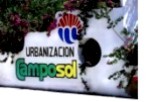 In Camposol, it is provided with an 18-hole golf course, a four star Sensol Resort and Hotel : Resort of thermal waters with 25 treatment boxes. In Camposol, it is provided with an 18-hole golf course, a four star Sensol Resort and Hotel : Resort of thermal waters with 25 treatment boxes.Tropical Pools and Spa. Golf Club House. Tennis courts. Bowling Alley, restaurants, bars, Traditional English Butchers selling fresh local meat, sausages, pies and selection of frozen products. For more information about the region, vieuw : Simply Networking Facilities of Residencial Camposol
|
 |
 |
 |
 |
 |
 |
 |
 |
 |
 |
 |
 Copyrights Copyrights Site beschermd door auteursrech ( pagina's, artikelen en foto's ) Site beschermd door auteursrech ( pagina's, artikelen en foto's ) Geen auteursrecht voor publicaties in Wikipedia = gratis reproductie toegestaan in Wikipedia Geen auteursrecht voor publicaties in Wikipedia = gratis reproductie toegestaan in Wikipedia Site protected by copyright ( pages, articles and photos ) Site protected by copyright ( pages, articles and photos ) No copyright for publications in Wikipedia = Free reproduction permitted in Wikipedia No copyright for publications in Wikipedia = Free reproduction permitted in Wikipedia Website urheberrechtlich geschützt ( Seiten, Artikeln und Fotos ) Website urheberrechtlich geschützt ( Seiten, Artikeln und Fotos ) Kein Urheberschutz für veröffentlichte, in Wikipedia = Freie Reproduktion erlaubt in Wikipedia Kein Urheberschutz für veröffentlichte, in Wikipedia = Freie Reproduktion erlaubt in Wikipedia Site protégé par les droits d'auteur ( pages, articles et photos ) Site protégé par les droits d'auteur ( pages, articles et photos ) Pas de droits d'auteur pour les publications dans Wikipedia = reproduction gratuite permise dans Wikipedia Pas de droits d'auteur pour les publications dans Wikipedia = reproduction gratuite permise dans Wikipedia Sitio protegido por derechos de autor ( paginas, articulos y fotos ) Sitio protegido por derechos de autor ( paginas, articulos y fotos ) No derechos de autor en las publicaciones en Wikipedia = Se permite la reproducción gratis en Wikipedia No derechos de autor en las publicaciones en Wikipedia = Se permite la reproducción gratis en Wikipedia |
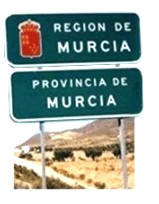 The Autonomous Community of the Region of Murcia (Spanish: Comunidad Autónoma de la Región de Murcia) is one of Spain's seventeen autonomous communities. It is located in the southeast of the country, between Andalusia and Valencian Community, on the Mediterranean coast.
The Autonomous Community of the Region of Murcia (Spanish: Comunidad Autónoma de la Región de Murcia) is one of Spain's seventeen autonomous communities. It is located in the southeast of the country, between Andalusia and Valencian Community, on the Mediterranean coast.

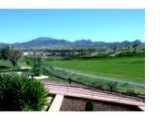 Health services - baths - medicinal SPA - heath and beauty treatments, leisure - bars and restaurants - bowling - flamenco evenings, dancing and dinners - various clubs, restaurants (chinese, indian, spanish, pizzerias, ...) - golf course (18 holes) - sporting zones - Sensol hotel and center of thalassotherapy - services of wellbeing and rest - commercial centres, shops, supermarket selling fresh fish, meat, bread and selection of wines and beers, "bodega", bricocenter, clothing, veterinary surgeons, opticians various services, banks, service station - parks - services of public transport (bus) - schools : Mazarron, Totana, Murcia ...;
Health services - baths - medicinal SPA - heath and beauty treatments, leisure - bars and restaurants - bowling - flamenco evenings, dancing and dinners - various clubs, restaurants (chinese, indian, spanish, pizzerias, ...) - golf course (18 holes) - sporting zones - Sensol hotel and center of thalassotherapy - services of wellbeing and rest - commercial centres, shops, supermarket selling fresh fish, meat, bread and selection of wines and beers, "bodega", bricocenter, clothing, veterinary surgeons, opticians various services, banks, service station - parks - services of public transport (bus) - schools : Mazarron, Totana, Murcia ...;  Sensol Hotel with golf course in Camposol. The Sensol Hotel is a modern and complete establishment, ideal to spend the holidays or for the business trips, or even to hold congresses and events. Located in Camposol - Mazarron, ( Murcia ), the Sensol Hotel offers modern and luxurious facilities. Its 164 rooms are totally equipped, stylishly decorated. From its windows and terraces, you could enjoy beautiful views over the Sensol hotel golf course with 18 holes.
Sensol Hotel with golf course in Camposol. The Sensol Hotel is a modern and complete establishment, ideal to spend the holidays or for the business trips, or even to hold congresses and events. Located in Camposol - Mazarron, ( Murcia ), the Sensol Hotel offers modern and luxurious facilities. Its 164 rooms are totally equipped, stylishly decorated. From its windows and terraces, you could enjoy beautiful views over the Sensol hotel golf course with 18 holes.